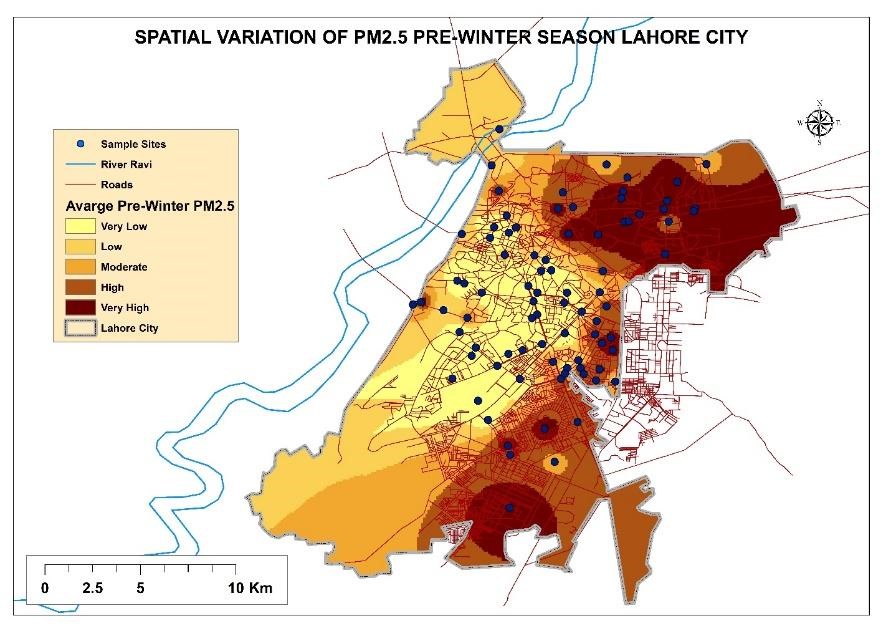Environmental Monitoring of Smog in Lahore Metropolitan Using GIS Technology
Keywords:
Smog, Particulate Matter, Land use, Land coverAbstract
Smog, a combination of polluted gasses or smoke with fog, brings a harmful breathing environment that mostly exists during the pre-winter season in Lahore. The smog episodes are prevailing over the city which are getting aggregated by smoky fumes, impurities, and dust particles. Severe smog episodes were observed over Lahore mainly during November and December 2019, resulting in adverse environmental conditions e.g., eye irritation, breathing difficulty, and creating very low visibility in and around Lahore. This study is based on eighty-five sample sites from all over Lahore city, to measure the Particulate Matter during smog season. In this study, the risk zones are demarcated based on land use and land covers during pre-winter seasons. It has been revealed through geospatial technology and the evaluation of weather data that local pollution has a greater contribution towards deteriorating the quality of air as compared to the contributions which are regionally active during the smog season. Spatial dispersion of smog has shown the local industrial and vehicular emissions as the major contributor of smog rather regional diffusion of pollutants.
References
M.S. Anjum, Ali SM, Imad-Ud-Din M, Subhani MA, Anwar MN, Nizami AS, Ashraf U, Khokhar MF. An Emerged Challenge of Air Pollution and Ever-Increasing Particulate Matter in Pakistan; A Critical Review. J Hazard Mater. 2021 Jan 15;402:123943. doi: 10.1016/j.jhazmat.2020.123943. Epub 2020 Sep 15. PMID: 33254830.
A. Hassan, Syed Zafar Ilyas, Simeon Agathopoulos, Syed Mujtaba Hussain, Abdul Jalil, Sarfraz Ahmed, Yadullah Baqir, Evaluation of adverse effects of particulate matter on human life, Heliyon,, Volume 7, Issue 2, 2021, e05968,
A. Shahid, M. Ansub, A. Hafeez, H. Saleem, and A. Basharat, “Socio-Economic Impacts of Transit Projects (A Case Study of Orange Line Lahore),” Saudi Journal of Civil Engineering, vol. 4, no. 9, pp. 161–169, 2020, DOI: 10.36348/sjce.2020.v04i09.004.
S. Raja, K. F. Biswas, L. Husain, and P. K. Hopke, “Source apportionment of the atmospheric aerosol in Lahore, Pakistan,” Water. Air. Soil Pollution., vol. 208, no. 1–4, pp. 43–57, May 2010, DOI: 10.1007/S11270-009-0148-Z.
“Lahore US Embassy, Pakistan Air Pollution: Real-time Air Quality Index.” https://aqicn.org/city/pakistan/lahore/us-embassy/ (accessed JunJune. 02, 2022).
“Pakistan National Ambient Air Quality Standards: A comparative Assessment with Selected Asian Countries and World Health Organization (WHO).” https://think-asia.org/handle/11540/12764 (accessed JunJune. 02, 2022).
F. Khanum, M. N. Chaudhry, and P. Kumar, “Characterization of five-year observation data of fine particulate matter in the metropolitan area of Lahore,” Air Quality Atmosphere & Heath., vol. 10, no. 6, pp. 725–736, 2017, DOI: 10.1007/s11869-017-0464-1.
H. Liu, Q. Li, D. Yu, and Y. Gu, “Applied Sciences Air Quality Index and Air Pollutant Concentration Prediction Based on Machine Learning Algorithms,” 1850. DOI: 10.3390/app9194069
T. Tabatabaie and F. Amiri, “Assessment of contribution of SO2, CO, and NO2 in different urban land use in Bushehr region, Iran,” rabian Journal of Geosciences 2021 1410, vol. 14, no. 10, pp. 1–11, May 2021, DOI: 10.1007/S12517-021-07164-6.
A. Rasheed, V. P. Aneja, A. Aiyyer, and U. Rafique, “Measurement and analysis of fine particulate matter (PM2.5) in urban areas of Pakistan,” erosol and Air Quality Research, vol. 15, no. 2, pp. 426–439, 2015, DOI: 10.4209/AAQR.2014.10.0269.
S. Babu Jallu, Riyaaz Uddien Shaik, Roshan Srivastav, Gloria Pignatta, Assessing the effect of covid-19 lockdown on surface urban heat island for different land use /cover types using remote sensing,, Energy Nexus, Volume 5, 2022, 100056
A. Lodhi, B. Ghauri, M. Rafiq Khan, S. Rahman, and S. Shafique, “Particulate matter (PM2.5) concentration and source apportionment in lahore,” Journal of the Brazilian Chemical Society., vol. 20, no. 10, pp. 1811–1820, 2009, DOI: 10.1590/S0103-50532009001000007.
U. Mehmood, A. Azhar, F. Qayyum, H. Nawaz, S. Tariq, and Z. ul Haq, “Air pollution and hospitalization in megacities: empirical evidence from Pakistan,” Environment. Science. Pollution. Research., vol. 28, no. 37, pp. 51384–51390, Oct. 2021, DOI: 10.1007/S11356-021-14158-0.
A. Ashraf, A. Butt, I. Khalid, R. U. Alam, and S. R. Ahmad, “Smog analysis and its effect on reported ocular surface diseases: A case study of 2016 smog event of Lahore,” Atmosphere. Environment., vol. 198, pp. 257–264, Feb. 2019, DOI: 10.1016/J.ATMOSENV.2018.10.029.
Y. Ali, M. Razi, F. De Felice, M. Sabir, and A. Petrillo, “A VIKOR based approach for assessing the social, environmental and economic effects of ‘smog’ on human health,” Science. Total Environment., vol. 650, pp. 2897–2905, Feb. 2019, DOI: 10.1016/J.SCITOTENV.2018.10.041.
R. Riaz and K. Hamid, “Existing Smog in Lahore, Pakistan: An Alarming Public Health Concern,” Cureus, vol. 10, no. 1, Jan. 2018, DOI: 10.7759/CUREUS.2111.
E. J. Highwood and R. P. Kinnersley, “When smoke gets in our eyes: the multiple impacts of atmospheric black carbon on climate, air quality and health,” Environment. International, vol. 32, no. 4, pp. 560–566, 2006, DOI: 10.1016/J.ENVINT.2005.12.003.
S. Raja, K. F. Biswas, L. Husain, and P. K. Hopke, “Source Apportionment of the Atmospheric Aerosol in Lahore, Pakistan,” Water, Air, Soil Pollution. 2009 2081, vol. 208, no. 1, pp. 43–57, Jun. 2009, DOI: 10.1007/S11270-009-0148-Z.
S. Abbas, G. Ali, F. M. Qamer, and S. M. Irteza, “Associations of air pollution concentrations and energy production dynamics in Pakistan during lockdown,” Environment. Science. Pollution. Research., vol. 29, no. 23, pp. 35036–35047, 2022, DOI: 10.1007/s11356-021-18071-4.

Published
How to Cite
Issue
Section
License
Copyright (c) 2022 50SEA

This work is licensed under a Creative Commons Attribution 4.0 International License.


















